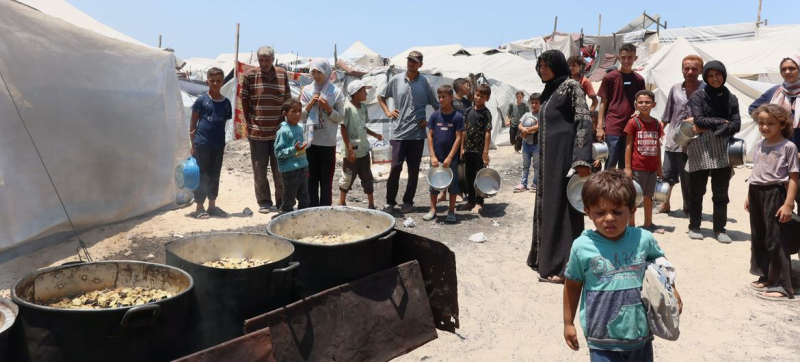- Govt to cut savings certificate profit rates from January |
- Gold prices hit fresh record in Bangladesh within 24 hours |
- Election to be held on time, Prof Yunus tells US Special Envoy |
- Moscow wants Dhaka to reduce tensions domestically, also with Delhi |
- Saarc experts meet to reduce livestock-origin greenhouse gases |
UNICEF Warns Gaza City Children ‘Fighting to Survive’

Families seek food at a community kitchen in western Gaza City.
The UN Children’s Fund (UNICEF) on Thursday urged the international community to do everything possible to prevent catastrophe in Gaza City, as Israel intensifies military operations ahead of a planned full takeover.
Tess Ingram, Communication Manager for UNICEF’s Middle East and North Africa Regional Office, recently spent nine days in Gaza City, describing it as “a city of fear, flight and funerals.”
“The last refuge for families in the northern Gaza Strip is fast becoming a place where childhood cannot survive,” she said, speaking from the enclave to journalists in New York.
Nearly a million people remain in Gaza City, where the collapse of essential services is leaving its youngest and most vulnerable residents “fighting for survival” as famine spreads and aid barely trickles in.
Only 44 of the 92 UNICEF-supported outpatient nutrition treatment centres are still functional, meaning thousands of malnourished children lack access to these critical lifelines.
Meanwhile, hospitals “are on their knees.” Only 11 remain partly functional, and just five have neonatal intensive care units (NICUs).
“The 40 incubators between them are running at up to 200 per cent capacity, meaning as many as 80 babies are fighting for life in overcrowded machines, utterly dependent on generators and medical supplies that may run dry at any moment,” Ms. Ingram said.
In Gaza City, she met displaced families fleeing once again, children separated from their parents, and mothers whose children had died of starvation or feared their own would be next.
“I’ve spoken to kids in hospital beds, their small bodies shredded by shrapnel,” she said. “The unthinkable is not looming. It is already here. The escalation is underway.”
Famine was “everywhere I looked in Gaza City,” she added. “Just an hour in a nutrition clinic is enough to erase any questions about whether there is a famine.”
At these clinics, waiting rooms are filled with tearful parents, children battling both disease and malnutrition, mothers unable to breastfeed, and “babies losing their vision, their hair and their strength to walk.”
Like elsewhere in the enclave, whole families are surviving on one bowl of lentils or rice a day from community kitchens. Parents often go without food so their children can eat.
Last week, Ms. Ingram visited a stabilisation centre that treats malnourished children and was shocked to find a woman named Nesma and her daughter, Jana.
UNICEF had evacuated Jana for treatment in southern Gaza more than a year ago, and she recovered. Jana and her mother later returned to northern Gaza during a ceasefire to reunite with their family.
“Then the blockade on aid continued, hunger returned, and this time both of Nesma’s children deteriorated.” Her two-year-old daughter Jouri died from malnutrition last month, and Jana “is barely hanging on.”
Ms. Ingram said children like Jana “are returning to emergency wards or relapsing just weeks after finishing treatment for malnutrition because of the ongoing lack of food, safe water and other essential supplies.”
She warned that “without immediate and increased access to food and nutrition treatments, this recurring nightmare will deepen and more children will starve – a fate that is entirely preventable.”
UNICEF continues to respond and in the past two weeks has provided partners on the ground with enough therapeutic food for more than 3,000 acutely malnourished children for six weeks of treatment. The agency also distributed supplementary food for 1,400 infants, high-energy biscuits for 4,600 pregnant and breastfeeding women, safe drinking water, and temporary learning centres.
“Our team is doing everything possible to help children, but we could do far more, reach every child here, if our operations were enabled at scale and if we were fully funded,” she stressed.
UNICEF is seeking $716 million this year for its response in Gaza, where needs are immense and child malnutrition continues to rise. In February, just over 2,000 youngsters were admitted for treatment; in July the number rose to 13,000, and by mid-August had already reached 7,200.
The agency continues to call on Israel to review its rules of engagement to ensure that children are protected, and for Hamas and other armed groups to release all remaining hostages.
Ms. Ingram underscored the need for Israel to allow sufficient aid into Gaza, while humanitarian workers must be able to safely reach families where they are.
Her final plea was for the international community, especially States and stakeholders with influence, to use their leverage to end the war now: “because the cost of inaction will be measured in the lives of children buried in the rubble, wasted by hunger and silenced before they even had a chance to speak.”

